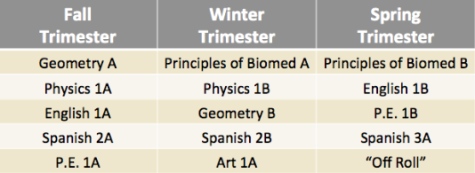Trimester System vs. Semester System: Which is Better?
A drawing illustrating the difference between the trimester system and the semester system. Both schedules have their upsides and downsides, but is one objectively “better”?
For Sage Creek High School students, we are all too familiar with the trimester system. Every 12 or so weeks, we receive a new schedule with five new classes and get to shuffle around our classes, teachers and classmates, while other schools stay the same all year long. While some find the trimester schedule more efficient, others think it causes too much stress for students.
So is it time for other schools to mix things up, or should Sage Creek go back to the schedule the rest of the district uses?
There are plenty of reasons why our school functions on the trimester system. Each trimester has the same amount of credits as a semester, so one could potentially take three years worth of a language in two years, try out electives they wouldn’t be able to take otherwise or even retake a course they failed within the same year.
The sports seasons also align with each trimester, which is generally more convenient for sports players.
Not to mention, the fast-paced nature of the trimester schedule means that students can take a break from classes they’re not necessarily fond of. Some students prefer to get classes over with quickly so they don’t have to worry about it for the rest of the year, even if that means having to go more quickly through the unit.
The frequent change in classes also gives more opportunities to meet new people and make friends.
A trimester system is not without its flaws, however, most notably being the speed at which we go through each class. While taking 15 classes per year instead of 12 can let students accelerate, students also spend a lot less time in each class, which can lead

to rushed units, extra homework and scheduling issues.
James Fieberg, a Sage Creek High School teacher who previously worked at Carlsbad High School, considers the benefits and drawbacks of following the trimester schedule.
“Personally, I prefer the semester system simply because we get more time with students, in terms of minutes per class,” Fieberg said. “However, there are plenty of advantages that come with the trimester system. Students can get their work done in 24 weeks rather than 36, which can let them take more classes and explore more opportunities.”
The alternative semester schedule is generally simpler and much slower, allowing students to spend more time on each class and stay with the same classes all year long. However, this generally means that students miss out on a lot of the benefits that the trimester allows for, like electives. This system also gives students six or seven classes to focus on a time, as opposed to the lighter workload of five classes the trimester system has.
So which system is objectively “better”? It’s really up to one’s personal strengths and weaknesses. Those who prefer to take extra classes while understanding it might be more difficult might do better in a trimester schedule, while those who would rather stick with the regular amount of work would likely do better in the semester schedule.



Steven Liles ◊ May 28, 2022 at 3:35 pm
I think it comes down to the type of student. In fact, I even once had a speech counselor say that the difference between Sage Creek and Carlsbad High is that Carlsbad is more for sports and Sage is more for intellects. The trimester system accelerates classes and provides a few extra for sharper students, in contrast to Carlsbad which uses semesters to teach the less achieving students more in-depth classes over a longer time frame.